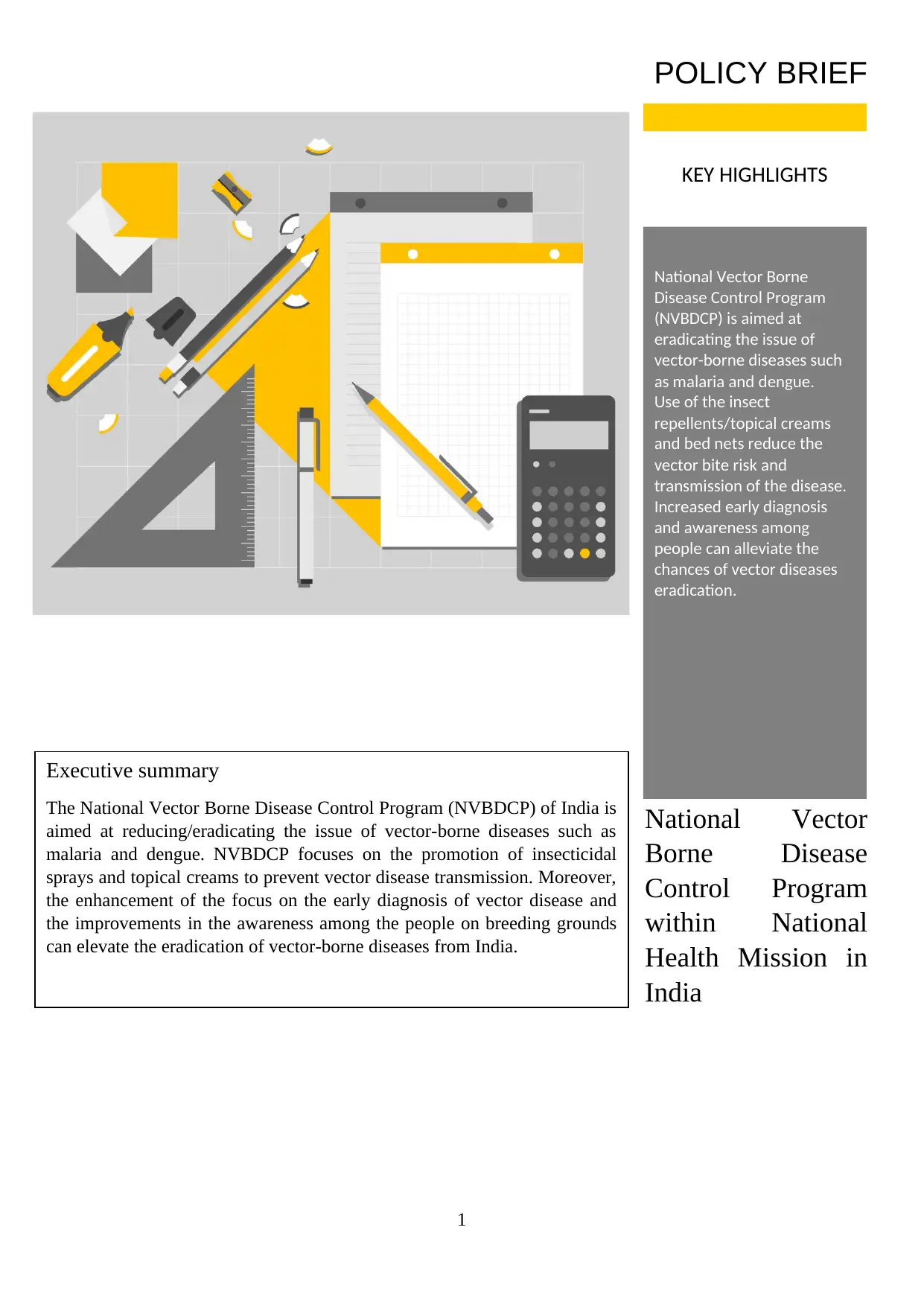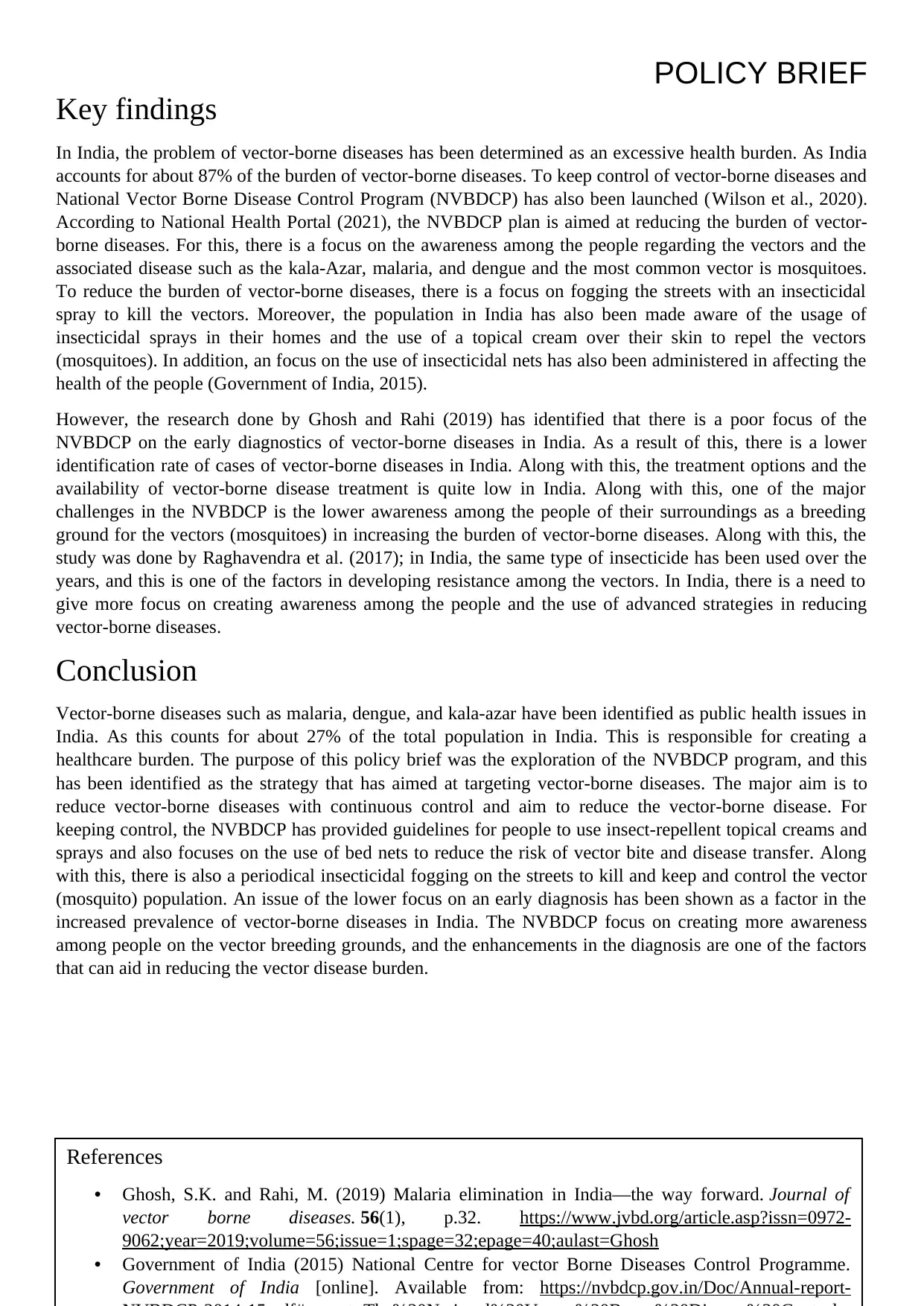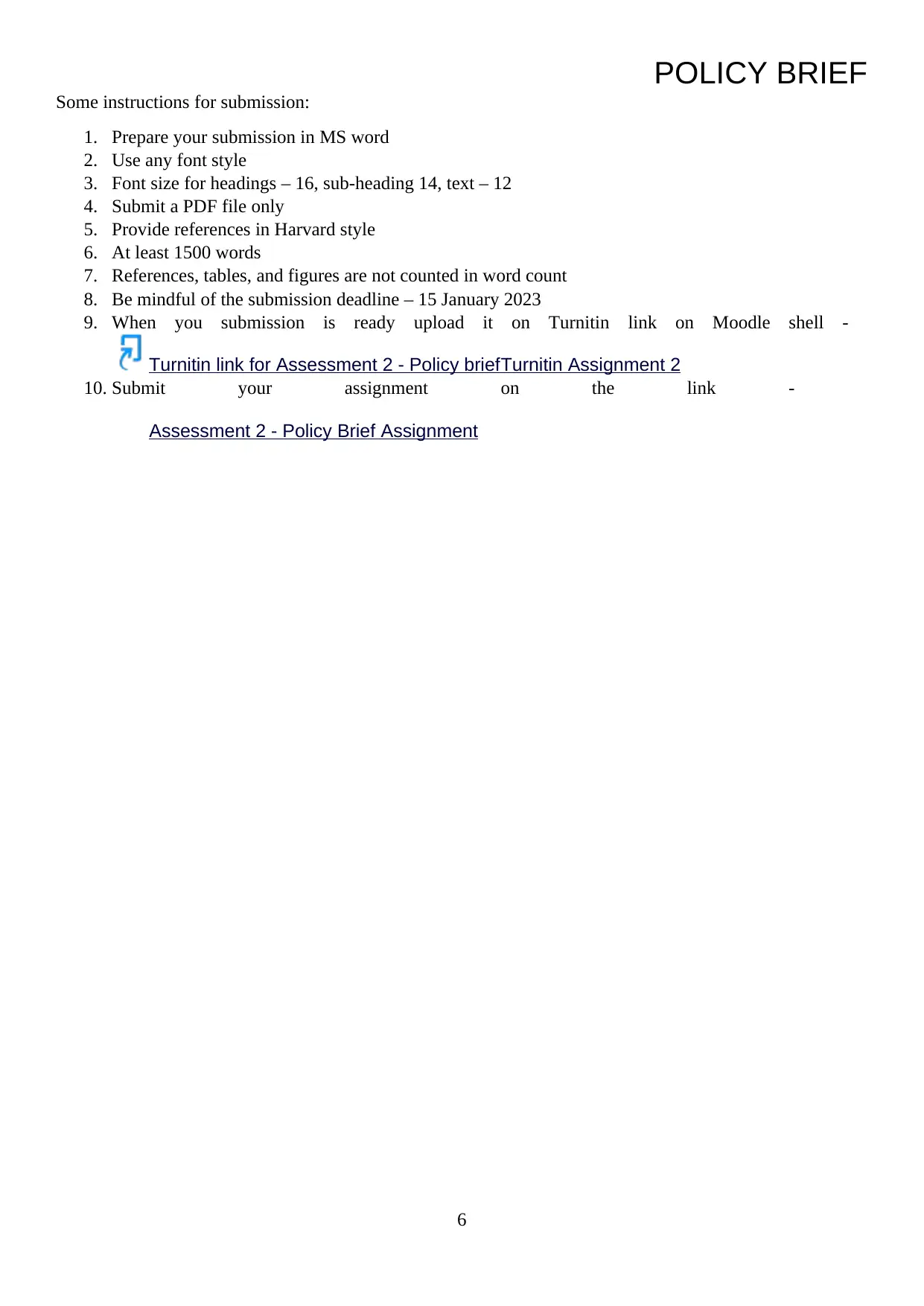National Vector Borne Disease Control Program within National Health Mission
VerifiedAdded on 2023/02/22
|6
|2479
|63
AI Summary
Contribute Materials
Your contribution can guide someone’s learning journey. Share your
documents today.

POLICY BRIEF
National Vector
Borne Disease
Control Program
within National
Health Mission in
India
1
National Vector Borne
Disease Control Program
(NVBDCP) is aimed at
eradicating the issue of
vector-borne diseases such
as malaria and dengue.
Use of the insect
repellents/topical creams
and bed nets reduce the
vector bite risk and
transmission of the disease.
Increased early diagnosis
and awareness among
people can alleviate the
chances of vector diseases
eradication.
KEY HIGHLIGHTS
Executive summary
The National Vector Borne Disease Control Program (NVBDCP) of India is
aimed at reducing/eradicating the issue of vector-borne diseases such as
malaria and dengue. NVBDCP focuses on the promotion of insecticidal
sprays and topical creams to prevent vector disease transmission. Moreover,
the enhancement of the focus on the early diagnosis of vector disease and
the improvements in the awareness among the people on breeding grounds
can elevate the eradication of vector-borne diseases from India.
National Vector
Borne Disease
Control Program
within National
Health Mission in
India
1
National Vector Borne
Disease Control Program
(NVBDCP) is aimed at
eradicating the issue of
vector-borne diseases such
as malaria and dengue.
Use of the insect
repellents/topical creams
and bed nets reduce the
vector bite risk and
transmission of the disease.
Increased early diagnosis
and awareness among
people can alleviate the
chances of vector diseases
eradication.
KEY HIGHLIGHTS
Executive summary
The National Vector Borne Disease Control Program (NVBDCP) of India is
aimed at reducing/eradicating the issue of vector-borne diseases such as
malaria and dengue. NVBDCP focuses on the promotion of insecticidal
sprays and topical creams to prevent vector disease transmission. Moreover,
the enhancement of the focus on the early diagnosis of vector disease and
the improvements in the awareness among the people on breeding grounds
can elevate the eradication of vector-borne diseases from India.
Secure Best Marks with AI Grader
Need help grading? Try our AI Grader for instant feedback on your assignments.

POLICY BRIEF
2
2

POLICY BRIEF
Introduction
In India, the problem of vector-borne diseases is one of the major public health issues. The majority of the
vector borne-diseases are caused as a result of infection from mosquitoes. In India, the problem of mosquito-
borne diseases is majorly caused during the times of the monsoon season. Approximately 27% of the
population is affected by the issue of vector-borne diseases (Sharma et al., 2017). The purpose of this policy
brief is to explore the policy of the National Vector Borne Diseases Control Programme (NVBDCP).
According to National Health Portal (2021), the programme of the NVBDCP has been launched in India to
keep control of vector-borne diseases. This includes a focus on the different vector-borne diseases such as
Dengue, Malaria, and kala-Azar. As per the Government of India (2015), the NVBDCP is a programme that
is aimed at reducing the risk of vector-borne diseases. For reducing vector-borne diseases, there is a focus on
the management of early detection and surveillance programmes throughout the country. According to
Raghavendra et al. (2017), vector-borne diseases include consideration of keeping control of the vectors
with the use of chemical insecticides. More than 2/3rd of vector-borne diseases have been found to be caused
as a result of malaria. The management of vector-borne diseases is based on the use of insecticidal sprays to
keep control of malaria/dengue.
Research Overview
The focus of this policy brief is on the exploration of the NVBDCP of the National Health Mission (NHM).
As per National Health Portal (2021), the NVBDCP is one of the programmes that has been launched in
India to focus on reducing the diseases associated with vector-borne diseases. The aim of the NVBDCP is to
use different prevention steps to reduce vector-borne diseases. These different strategies have been
developed to keep control of various diseases such as malaria, dengue, and kala-azar. A focus has been
given to keeping track of the epidemiology of the risk of vector growth and keeping control of the number of
the vector. The reduction in the number of vectors is one of the best strategies identified in keeping control
of health and well-being that leads to the promotion of better health. In addition, as per the Government of
India (2015), the NVBDCP includes different strategies for vector-borne diseases with the consideration of
supportive interventions. This focuses on creating awareness among the people and leading to a behaviour
change that can aid in reducing the breeding grounds for mosquitoes and help to keep control of vector
diseases. Moreover, the major focus of the NVBDCP is majorly on administering insecticidal sprays to keep
control of the vectors and reduce the risk of disease transmission.
According to Wilson et al. (2020), the focus of vector-borne diseases is majorly on the principles of control
over the vectors. As the focus is on the use of bed nets during sleep, topical repellents to reduce the vectors
and the use of insecticidal tools to reduce the risk of bite by the vectors such as mosquitoes. These different
techniques of vector-borne diseases are also included in the NVBDCP programme of India. According to
Ghosh and Rahi (2019), India contributes about 4% of the total global burden for the vector-borne diseases
of malaria, and in South-East Asia, there is about 87% burden on the malarial development. Moreover, the
NVBDCP has reported a total of 0.84 million cases of the vector-borne disease of malaria. However, in the
NVBDCP, there is a lower focus on the diagnosis of the population to determine the people affected with
vector-borne diseases. Early diagnosis intervention for the population in India can facilitate in enhancing the
promotion of better health. Moreover, in the case of asymptomatic vector-borne diseases such as malaria,
there is a higher increase in the effects on the health of the population. In addition, one of the challenges to
the NVBDCP also includes the adverse effects of poor treatment and the factors that have a change affecting
health and well-being, leading to poor health.
3
Introduction
In India, the problem of vector-borne diseases is one of the major public health issues. The majority of the
vector borne-diseases are caused as a result of infection from mosquitoes. In India, the problem of mosquito-
borne diseases is majorly caused during the times of the monsoon season. Approximately 27% of the
population is affected by the issue of vector-borne diseases (Sharma et al., 2017). The purpose of this policy
brief is to explore the policy of the National Vector Borne Diseases Control Programme (NVBDCP).
According to National Health Portal (2021), the programme of the NVBDCP has been launched in India to
keep control of vector-borne diseases. This includes a focus on the different vector-borne diseases such as
Dengue, Malaria, and kala-Azar. As per the Government of India (2015), the NVBDCP is a programme that
is aimed at reducing the risk of vector-borne diseases. For reducing vector-borne diseases, there is a focus on
the management of early detection and surveillance programmes throughout the country. According to
Raghavendra et al. (2017), vector-borne diseases include consideration of keeping control of the vectors
with the use of chemical insecticides. More than 2/3rd of vector-borne diseases have been found to be caused
as a result of malaria. The management of vector-borne diseases is based on the use of insecticidal sprays to
keep control of malaria/dengue.
Research Overview
The focus of this policy brief is on the exploration of the NVBDCP of the National Health Mission (NHM).
As per National Health Portal (2021), the NVBDCP is one of the programmes that has been launched in
India to focus on reducing the diseases associated with vector-borne diseases. The aim of the NVBDCP is to
use different prevention steps to reduce vector-borne diseases. These different strategies have been
developed to keep control of various diseases such as malaria, dengue, and kala-azar. A focus has been
given to keeping track of the epidemiology of the risk of vector growth and keeping control of the number of
the vector. The reduction in the number of vectors is one of the best strategies identified in keeping control
of health and well-being that leads to the promotion of better health. In addition, as per the Government of
India (2015), the NVBDCP includes different strategies for vector-borne diseases with the consideration of
supportive interventions. This focuses on creating awareness among the people and leading to a behaviour
change that can aid in reducing the breeding grounds for mosquitoes and help to keep control of vector
diseases. Moreover, the major focus of the NVBDCP is majorly on administering insecticidal sprays to keep
control of the vectors and reduce the risk of disease transmission.
According to Wilson et al. (2020), the focus of vector-borne diseases is majorly on the principles of control
over the vectors. As the focus is on the use of bed nets during sleep, topical repellents to reduce the vectors
and the use of insecticidal tools to reduce the risk of bite by the vectors such as mosquitoes. These different
techniques of vector-borne diseases are also included in the NVBDCP programme of India. According to
Ghosh and Rahi (2019), India contributes about 4% of the total global burden for the vector-borne diseases
of malaria, and in South-East Asia, there is about 87% burden on the malarial development. Moreover, the
NVBDCP has reported a total of 0.84 million cases of the vector-borne disease of malaria. However, in the
NVBDCP, there is a lower focus on the diagnosis of the population to determine the people affected with
vector-borne diseases. Early diagnosis intervention for the population in India can facilitate in enhancing the
promotion of better health. Moreover, in the case of asymptomatic vector-borne diseases such as malaria,
there is a higher increase in the effects on the health of the population. In addition, one of the challenges to
the NVBDCP also includes the adverse effects of poor treatment and the factors that have a change affecting
health and well-being, leading to poor health.
3

POLICY BRIEF
Key findings
In India, the problem of vector-borne diseases has been determined as an excessive health burden. As India
accounts for about 87% of the burden of vector-borne diseases. To keep control of vector-borne diseases and
National Vector Borne Disease Control Program (NVBDCP) has also been launched (Wilson et al., 2020).
According to National Health Portal (2021), the NVBDCP plan is aimed at reducing the burden of vector-
borne diseases. For this, there is a focus on the awareness among the people regarding the vectors and the
associated disease such as the kala-Azar, malaria, and dengue and the most common vector is mosquitoes.
To reduce the burden of vector-borne diseases, there is a focus on fogging the streets with an insecticidal
spray to kill the vectors. Moreover, the population in India has also been made aware of the usage of
insecticidal sprays in their homes and the use of a topical cream over their skin to repel the vectors
(mosquitoes). In addition, an focus on the use of insecticidal nets has also been administered in affecting the
health of the people (Government of India, 2015).
However, the research done by Ghosh and Rahi (2019) has identified that there is a poor focus of the
NVBDCP on the early diagnostics of vector-borne diseases in India. As a result of this, there is a lower
identification rate of cases of vector-borne diseases in India. Along with this, the treatment options and the
availability of vector-borne disease treatment is quite low in India. Along with this, one of the major
challenges in the NVBDCP is the lower awareness among the people of their surroundings as a breeding
ground for the vectors (mosquitoes) in increasing the burden of vector-borne diseases. Along with this, the
study was done by Raghavendra et al. (2017); in India, the same type of insecticide has been used over the
years, and this is one of the factors in developing resistance among the vectors. In India, there is a need to
give more focus on creating awareness among the people and the use of advanced strategies in reducing
vector-borne diseases.
Conclusion
Vector-borne diseases such as malaria, dengue, and kala-azar have been identified as public health issues in
India. As this counts for about 27% of the total population in India. This is responsible for creating a
healthcare burden. The purpose of this policy brief was the exploration of the NVBDCP program, and this
has been identified as the strategy that has aimed at targeting vector-borne diseases. The major aim is to
reduce vector-borne diseases with continuous control and aim to reduce the vector-borne disease. For
keeping control, the NVBDCP has provided guidelines for people to use insect-repellent topical creams and
sprays and also focuses on the use of bed nets to reduce the risk of vector bite and disease transfer. Along
with this, there is also a periodical insecticidal fogging on the streets to kill and keep and control the vector
(mosquito) population. An issue of the lower focus on an early diagnosis has been shown as a factor in the
increased prevalence of vector-borne diseases in India. The NVBDCP focus on creating more awareness
among people on the vector breeding grounds, and the enhancements in the diagnosis are one of the factors
that can aid in reducing the vector disease burden.
4
References
• Ghosh, S.K. and Rahi, M. (2019) Malaria elimination in India—the way forward. Journal of
vector borne diseases. 56(1), p.32. https://www.jvbd.org/article.asp?issn=0972-
9062;year=2019;volume=56;issue=1;spage=32;epage=40;aulast=Ghosh
• Government of India (2015) National Centre for vector Borne Diseases Control Programme.
Government of India [online]. Available from: https://nvbdcp.gov.in/Doc/Annual-report-
Key findings
In India, the problem of vector-borne diseases has been determined as an excessive health burden. As India
accounts for about 87% of the burden of vector-borne diseases. To keep control of vector-borne diseases and
National Vector Borne Disease Control Program (NVBDCP) has also been launched (Wilson et al., 2020).
According to National Health Portal (2021), the NVBDCP plan is aimed at reducing the burden of vector-
borne diseases. For this, there is a focus on the awareness among the people regarding the vectors and the
associated disease such as the kala-Azar, malaria, and dengue and the most common vector is mosquitoes.
To reduce the burden of vector-borne diseases, there is a focus on fogging the streets with an insecticidal
spray to kill the vectors. Moreover, the population in India has also been made aware of the usage of
insecticidal sprays in their homes and the use of a topical cream over their skin to repel the vectors
(mosquitoes). In addition, an focus on the use of insecticidal nets has also been administered in affecting the
health of the people (Government of India, 2015).
However, the research done by Ghosh and Rahi (2019) has identified that there is a poor focus of the
NVBDCP on the early diagnostics of vector-borne diseases in India. As a result of this, there is a lower
identification rate of cases of vector-borne diseases in India. Along with this, the treatment options and the
availability of vector-borne disease treatment is quite low in India. Along with this, one of the major
challenges in the NVBDCP is the lower awareness among the people of their surroundings as a breeding
ground for the vectors (mosquitoes) in increasing the burden of vector-borne diseases. Along with this, the
study was done by Raghavendra et al. (2017); in India, the same type of insecticide has been used over the
years, and this is one of the factors in developing resistance among the vectors. In India, there is a need to
give more focus on creating awareness among the people and the use of advanced strategies in reducing
vector-borne diseases.
Conclusion
Vector-borne diseases such as malaria, dengue, and kala-azar have been identified as public health issues in
India. As this counts for about 27% of the total population in India. This is responsible for creating a
healthcare burden. The purpose of this policy brief was the exploration of the NVBDCP program, and this
has been identified as the strategy that has aimed at targeting vector-borne diseases. The major aim is to
reduce vector-borne diseases with continuous control and aim to reduce the vector-borne disease. For
keeping control, the NVBDCP has provided guidelines for people to use insect-repellent topical creams and
sprays and also focuses on the use of bed nets to reduce the risk of vector bite and disease transfer. Along
with this, there is also a periodical insecticidal fogging on the streets to kill and keep and control the vector
(mosquito) population. An issue of the lower focus on an early diagnosis has been shown as a factor in the
increased prevalence of vector-borne diseases in India. The NVBDCP focus on creating more awareness
among people on the vector breeding grounds, and the enhancements in the diagnosis are one of the factors
that can aid in reducing the vector disease burden.
4
References
• Ghosh, S.K. and Rahi, M. (2019) Malaria elimination in India—the way forward. Journal of
vector borne diseases. 56(1), p.32. https://www.jvbd.org/article.asp?issn=0972-
9062;year=2019;volume=56;issue=1;spage=32;epage=40;aulast=Ghosh
• Government of India (2015) National Centre for vector Borne Diseases Control Programme.
Government of India [online]. Available from: https://nvbdcp.gov.in/Doc/Annual-report-
Secure Best Marks with AI Grader
Need help grading? Try our AI Grader for instant feedback on your assignments.

POLICY BRIEF
5
5

POLICY BRIEF
Some instructions for submission:
1. Prepare your submission in MS word
2. Use any font style
3. Font size for headings – 16, sub-heading 14, text – 12
4. Submit a PDF file only
5. Provide references in Harvard style
6. At least 1500 words
7. References, tables, and figures are not counted in word count
8. Be mindful of the submission deadline – 15 January 2023
9. When you submission is ready upload it on Turnitin link on Moodle shell -
Turnitin link for Assessment 2 - Policy briefTurnitin Assignment 2
10. Submit your assignment on the link -
Assessment 2 - Policy Brief Assignment
6
Some instructions for submission:
1. Prepare your submission in MS word
2. Use any font style
3. Font size for headings – 16, sub-heading 14, text – 12
4. Submit a PDF file only
5. Provide references in Harvard style
6. At least 1500 words
7. References, tables, and figures are not counted in word count
8. Be mindful of the submission deadline – 15 January 2023
9. When you submission is ready upload it on Turnitin link on Moodle shell -
Turnitin link for Assessment 2 - Policy briefTurnitin Assignment 2
10. Submit your assignment on the link -
Assessment 2 - Policy Brief Assignment
6
1 out of 6
Your All-in-One AI-Powered Toolkit for Academic Success.
+13062052269
info@desklib.com
Available 24*7 on WhatsApp / Email
![[object Object]](/_next/static/media/star-bottom.7253800d.svg)
Unlock your academic potential
© 2024 | Zucol Services PVT LTD | All rights reserved.


